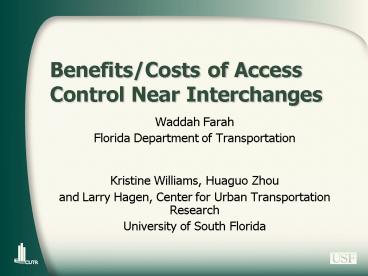BenefitsCosts of Access Control Near Interchanges PowerPoint PPT Presentation
1 / 27
Title: BenefitsCosts of Access Control Near Interchanges
1
Benefits/Costs of Access Control Near Interchanges
- Waddah Farah
- Florida Department of Transportation
- Kristine Williams, Huaguo Zhou
- and Larry Hagen, Center for Urban Transportation
Research - University of South Florida
2
Interchange Access Problems
Intersecting Road
I-4 Exit Ramp
Traffic merging onto the crossroad frequently
backs up onto I-4 due to proximity of the first
signalized intersection.
3
Problem Statement
- Access connections near an interchange off-ramp
can cause safety and operational problems - Is it cost-effective to control access by
acquiring more LA ROW?
4
Background
- Interchanges attract development
- Seldom any coordinated plan
- FDOT has no control over land-use
- Current practice is to acquire 100 ft of LA ROW
in urban areas, 300 ft in rural areas - ROW costs are prohibitive in developed
interchange areas
5
Methodology
- Operational Analysis
- Extend the operational life of interchange
- Delay savings by increasing the length of access
controlled frontage - Safety Analysis
- Effects of access spacing on crash frequency
- B/C Analysis
- Computing B/C ratio for three scenarios
6
Original Interchange Model
7
Operational Analysis (Corsim)
- Modify the existing interchange configuration to
an average urban diamond design - Simulate the operational impacts of 200 feet
access spacing - Continue to simulate the impacts of access
spacing at 200-foot increments
8
New Simulation Model
9
Assumptions
- Traffic volume proportion on freeway ramp
- Traffic volume proportion on arterial
- Intersection turning movement counts
- Proportion of weaving vehicles
- Heavy vehicle percentage
- Signal progression effects
10
Operational Effects
11
Reduced Delay (per hour)
- 20 years
- Total reduced delay for 600 vs. 200 is about
6950 veh-hrs - Total reduced delay for 1320 vs. 200 is about
7730 veh-hrs
12
Safety Analysis
- Objective
- to relate crash frequency to the length of access
controlled frontage - Data Collection
- 11 Study Sites
- Crash Data from Year 1999 to 2003
13
Safety Analysis
14
Safety Analysis (Contd)
15
Safety Analysis (Contd)
16
Safety Analysis (Contd)
17
Benefit/Cost Analysis
- B/C? user benefits/? investment cost
- Alternative A Purchasing 200 ft of LA Right of
Way (Current Practice) - Alternative B Purchasing 600 ft of LA Right of
Way - Alternative C Purchasing 1320 ft of LA Right of
Way
18
Constants for Operational Benefits
- Vehicle Occupancy 1.25 persons per vehicle
- Working Days 250 days per year
- Average Cost of Time (2002) 13.25 per person
hour - Source TTI Urban Mobility Study 2002
19
Average ROW Costs (per front foot)
- Rural Unimproved 500
- Rural improved 1,000
- Urban unimproved 1,625
- Urban improved 15,000
- Source FDOT D7
20
Average Cost of Crashes
- Death 1,120,000
- Nonfatal Disability Injury 45,500
- PDO 8,200
- Source National Safety Council 2003
21
Benefits and Costs
- Benefits
- Savings of Not Purchasing LA ROW on Developed
Land (B1) - Decreased Delay (B2)
- Fewer Crashes (B3)
- Costs
- Initial Cost of Purchasing Additional LA Right of
Way on Undeveloped Land (C1)
22
B/C Ratio
- Alternative A (200 ft) vs. Alternative B (600
ft) - Alternative A (200 ft) vs. Alternative C (1320 ft)
23
Benefit/Cost Ratio - 200 vs. 600
24
Benefit/Cost Ratio - 200 vs. 1320
25
Conclusions
- The benefits of acquiring additional LA ROW near
an interchange in advance of development far
exceed the cost. - Minimum Length of LA ROW 600 feet
- Desirable Length of LA ROW 1320 feet
26
Its a Win-Win
27
For Further Information
www.cutr.usf.edu
Kristine M. Williams, AICP Program
Director Planning Corridor Management kwilliams_at_
cutr.usf.edu 813-974-9807

